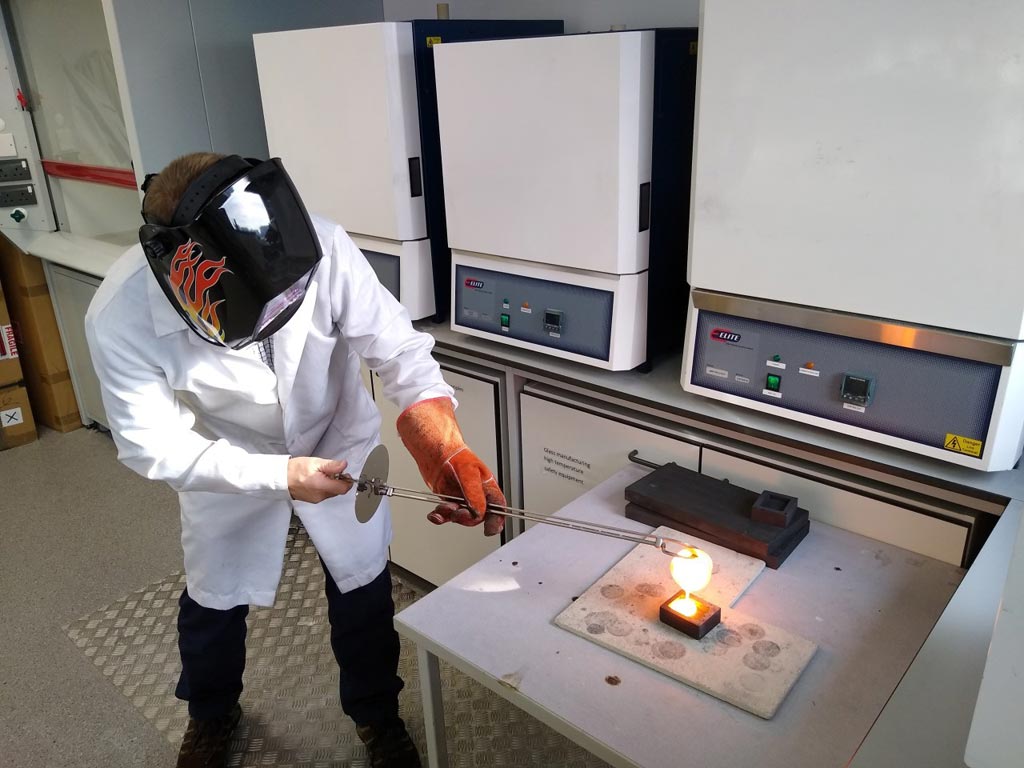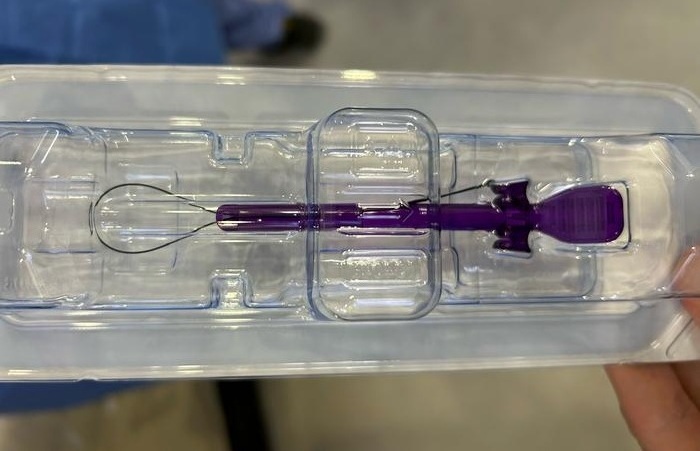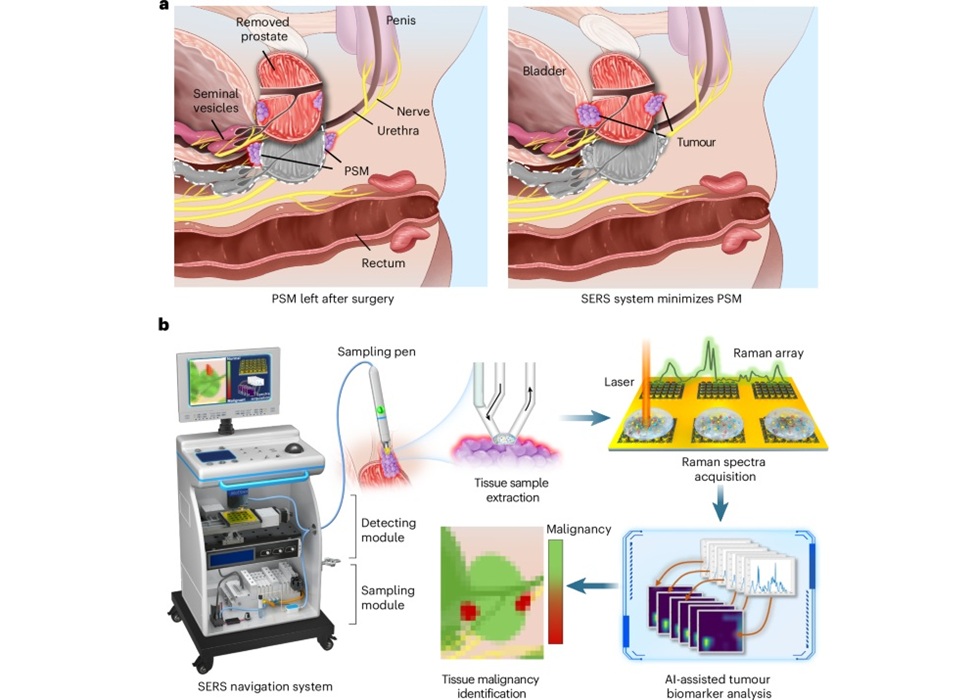Glass-Coated Catheter Inserts Protect against Nosocomial Infection
|
By HospiMedica International staff writers Posted on 23 Oct 2019 |

Image: Aston researcher preparing a ZnO laced glass rod (Photo courtesy of Aston University).
A phosphate glass compound containing small amounts of zinc oxide (ZnO) can help eradicate the urinary tract infections (UTIs) that plague catheter patients, according to a new study.
To develop the new catheter coating, researchers at Aston University (Birmingham, United Kingdom) heated phosphate-based glass rods (P2O5)50(Na2O)20(CaO)30 in a furnace to over 1,000°C, before slowly cooling them down to room temperature. The rods were then separated into small discs and placed into contact with bacteria in petri dishes. The rods were laced with ZnO in various concentrations order to determine the antimicrobial effects of increasing ionic degradation. They found that while 1 and 3 mol% ZnO decreased glass degradation, a higher dissolution rate was observed for 5 and 10 mol%.
They found that the higher the ZnO concentration, the larger the effect against microorganisms known to cause hospital-acquired infections (HAIs). When in direct contact, the ZnO-doped glasses showed a complete kill within 24 hours against Escherichia coli, and a significant kill rate of methicillin-resistant Staphylococcus aureus (MRSA), with complete kill achieved after 48 hours. Cytotoxic studies showed no toxic effects on the viability of uroepithelial cells. The study was published in the October 2019 issue of Materials Science & Engineering C.
“Zinc oxide coated phosphate glass, inserted into catheters, has to potential to eradicate the most common bacteria in catheter-associated UTI, E.coli and Staphylococcus aureus,” said senior author Richard Martin, PhD, of the School of Engineering and Applied Science. “This is great news for patients requiring catheters, who would be at a much-reduced risk of contracting a potentially life-threatening UTI during a hospital stay. It is also good for healthcare systems, which could save millions in the costs associated with these infections.”
A UTI is an infection involving any part of the urinary system, including urethra, bladder, ureters, and kidney. Among UTIs acquired in the hospital, approximately 75% are associated with a urinary catheter inserted into the bladder through the urethra to drain urine, which are indicated in between 15-25% of hospitalized patients. The most important risk factor for developing a catheter-associated UTI (CAUTI) is prolonged use of the urinary catheter.
Related Links:
Aston University
To develop the new catheter coating, researchers at Aston University (Birmingham, United Kingdom) heated phosphate-based glass rods (P2O5)50(Na2O)20(CaO)30 in a furnace to over 1,000°C, before slowly cooling them down to room temperature. The rods were then separated into small discs and placed into contact with bacteria in petri dishes. The rods were laced with ZnO in various concentrations order to determine the antimicrobial effects of increasing ionic degradation. They found that while 1 and 3 mol% ZnO decreased glass degradation, a higher dissolution rate was observed for 5 and 10 mol%.
They found that the higher the ZnO concentration, the larger the effect against microorganisms known to cause hospital-acquired infections (HAIs). When in direct contact, the ZnO-doped glasses showed a complete kill within 24 hours against Escherichia coli, and a significant kill rate of methicillin-resistant Staphylococcus aureus (MRSA), with complete kill achieved after 48 hours. Cytotoxic studies showed no toxic effects on the viability of uroepithelial cells. The study was published in the October 2019 issue of Materials Science & Engineering C.
“Zinc oxide coated phosphate glass, inserted into catheters, has to potential to eradicate the most common bacteria in catheter-associated UTI, E.coli and Staphylococcus aureus,” said senior author Richard Martin, PhD, of the School of Engineering and Applied Science. “This is great news for patients requiring catheters, who would be at a much-reduced risk of contracting a potentially life-threatening UTI during a hospital stay. It is also good for healthcare systems, which could save millions in the costs associated with these infections.”
A UTI is an infection involving any part of the urinary system, including urethra, bladder, ureters, and kidney. Among UTIs acquired in the hospital, approximately 75% are associated with a urinary catheter inserted into the bladder through the urethra to drain urine, which are indicated in between 15-25% of hospitalized patients. The most important risk factor for developing a catheter-associated UTI (CAUTI) is prolonged use of the urinary catheter.
Related Links:
Aston University
Latest Critical Care News
- Magnetically Guided Microrobots to Enable Targeted Drug Delivery

- Smart Nanomaterials Detect and Treat Traumatic Brain Injuries Simultaneously
- Earlier Blood Transfusion Could Reduce Heart Failure and Arrhythmia in Heart Disease Patients
- 'Smart' Shirt Detects Epileptic Seizures in Real Time
- Skin Patch Measures Effectiveness of Flu/COVID Vaccines in 10 Minutes
- Complete Revascularization Reduces Risk of Death from Cardiovascular Causes
- Tiny Fish-Inspired Robots Navigate Through Body to Deliver Targeted Drug Therapy
- Coronary Artery Stenosis Could Protect Patients from Pulmonary Embolism Effects
- Sweat-Powered Sticker Turns Drinking Cup into Health Sensor
- Skin-Mounted 3D Microfluidic Device Analyzes Sweat for Real-Time Health Assessment
- New Therapeutic Brain Implants to Eliminate Need for Surgery
- Stem Cell Patch Gently Heals Damaged Hearts Without Open-Heart Surgery
- Biomaterial Vaccines to Make Implanted Orthopedic Devices Safer
- Deep Learning Model Predicts Sepsis Patients Likely to Benefit from Steroid Treatment
- Programmable Drug-Delivery Patch Promotes Healing and Regrowth After Heart Attack
- Breakthrough Ultrasound Technology Measures Blood Viscosity in Real Time
Channels
Surgical Techniques
view channel
New Study Findings Could Halve Number of Stent Procedures
When a coronary artery becomes acutely blocked during a heart attack, opening it immediately is essential to prevent irreversible damage. However, many patients also have other narrowed vessels that appear... Read more
Breakthrough Surgical Device Redefines Hip Arthroscopy
Hip arthroscopy has surged in popularity, yet surgeons still face major mechanical constraints when navigating deep joint spaces through traditional cannulas. Limited tool mobility and the need for an... Read morePatient Care
view channel
Revolutionary Automatic IV-Line Flushing Device to Enhance Infusion Care
More than 80% of in-hospital patients receive intravenous (IV) therapy. Every dose of IV medicine delivered in a small volume (<250 mL) infusion bag should be followed by subsequent flushing to ensure... Read more
VR Training Tool Combats Contamination of Portable Medical Equipment
Healthcare-associated infections (HAIs) impact one in every 31 patients, cause nearly 100,000 deaths each year, and cost USD 28.4 billion in direct medical expenses. Notably, up to 75% of these infections... Read more
Portable Biosensor Platform to Reduce Hospital-Acquired Infections
Approximately 4 million patients in the European Union acquire healthcare-associated infections (HAIs) or nosocomial infections each year, with around 37,000 deaths directly resulting from these infections,... Read moreFirst-Of-Its-Kind Portable Germicidal Light Technology Disinfects High-Touch Clinical Surfaces in Seconds
Reducing healthcare-acquired infections (HAIs) remains a pressing issue within global healthcare systems. In the United States alone, 1.7 million patients contract HAIs annually, leading to approximately... Read moreHealth IT
view channel
Printable Molecule-Selective Nanoparticles Enable Mass Production of Wearable Biosensors
The future of medicine is likely to focus on the personalization of healthcare—understanding exactly what an individual requires and delivering the appropriate combination of nutrients, metabolites, and... Read moreBusiness
view channel
Philips and Masimo Partner to Advance Patient Monitoring Measurement Technologies
Royal Philips (Amsterdam, Netherlands) and Masimo (Irvine, California, USA) have renewed their multi-year strategic collaboration, combining Philips’ expertise in patient monitoring with Masimo’s noninvasive... Read more
B. Braun Acquires Digital Microsurgery Company True Digital Surgery
The high-end microsurgery market in neurosurgery, spine, and ENT is undergoing a significant transformation. Traditional analog microscopes are giving way to digital exoscopes, which provide improved visualization,... Read more
CMEF 2025 to Promote Holistic and High-Quality Development of Medical and Health Industry
The 92nd China International Medical Equipment Fair (CMEF 2025) Autumn Exhibition is scheduled to be held from September 26 to 29 at the China Import and Export Fair Complex (Canton Fair Complex) in Guangzhou.... Read more







.jpg)






